(Kali
Rolling Edition:
Lesson 1)
{ Installing Kali Rolling
Edition - 2023 }
|
Section 0. Background
Information |
- What is Kali
- Kali Linux is a Debian-based Linux
distribution aimed at advanced Penetration Testing and Security
Auditing. Kali contains several hundred tools which are geared towards
various information security tasks, such as Penetration Testing,
Security research, Computer Forensics and Reverse Engineering. Kali
Linux is developed, funded and maintained by Offensive Security.
-
http://docs.kali.org/introduction/what-is-kali-linux
-
Lab Notes
- In this lab we will do the following:
- Download the Kali Rolling Edition ISO.
- Create a VMware Virtual Machine using
the Kali Rolling Edition ISO.
- Update the Package Repository
- Perform a Full Upgrade
- Install Open VMware Tools for virtual
machines
- Legal Disclaimer
- As a condition of your use of this Web
site, you warrant to computersecuritystudent.com that you will not use
this Web site for any purpose that is unlawful or
that is prohibited by these terms, conditions, and notices.
- In accordance with UCC § 2-316, this
product is provided with "no warranties, either express or implied." The
information contained is provided "as-is", with "no guarantee of
merchantability."
- In addition, this is a teaching website
that does not condone malicious behavior of
any kind.
- You are on notice, that continuing
and/or using this lab outside your "own" test environment
is considered malicious and is against the law.
- © 2024 No content replication of any
kind is allowed without express written permission.
|
Section 1. Download
Kali ISO |
- Open Firefox
- Instructions:
- Click the Start Button
- Type
firefox in the
search box
- Click the Firefox icon
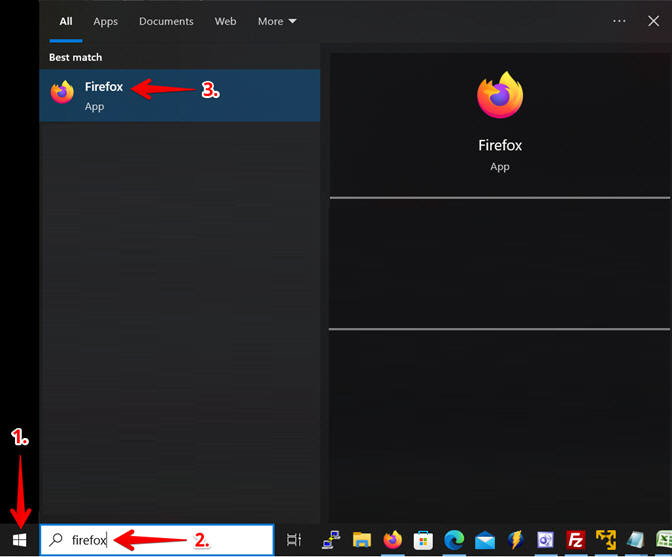
- Add Menu Bar
- Instructions:
- Right Click Next to the tab
- Select the Menu Bar
- Configure Settings
- Instructions:
- Click on Tools
- Click on Settings
- Configure Download Location
- Instructions:
- Search for downloads
- Click the radio button Always ask me
where to save files
- Note(FYI):
- This is optional. The goal is to make
you aware of your file download location.

- Start the Kali 2013.x Download
- Instructions:
- Navigate to the following
download URL
- https://old.kali.org/kali-images/kali-2024.3/kali-linux-2024.3-installer-amd64.iso
- https://old.kali.org/kali-images/kali-2023.4/kali-linux-2023.4-installer-amd64.iso
- Navigate to the Downloads
director
- File name:
kali-linux-2023.4-installer-amd64
- Click the Save Button
- Note(FYI):
- You can select a different
download directory.
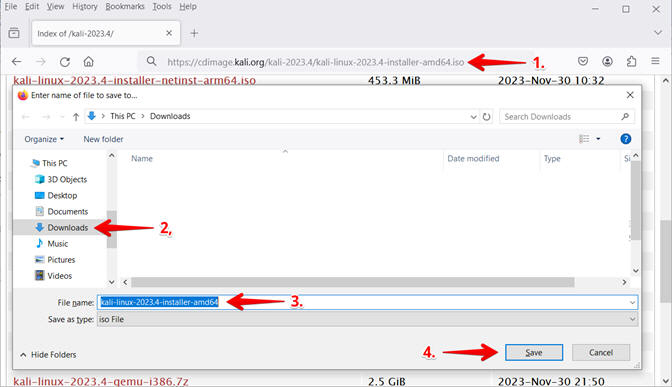
|
Section 2. Create a
New Virtual Machine |
- Open VMware Player on your windows machine.
- Instructions:
- Type "vmware" in the search box
- Click on VMware Workstation 17 Player
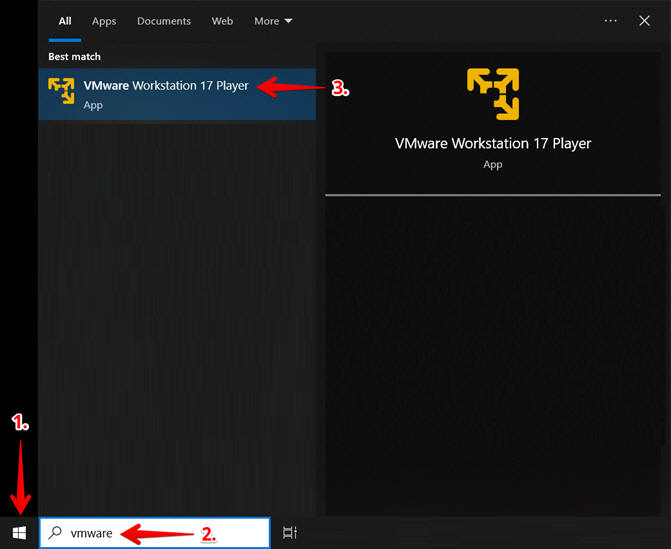
- Create a New Virtual Machine. (See Below)
- Instructions:
- Click on Home
- Click on Create a New Virtual Machine
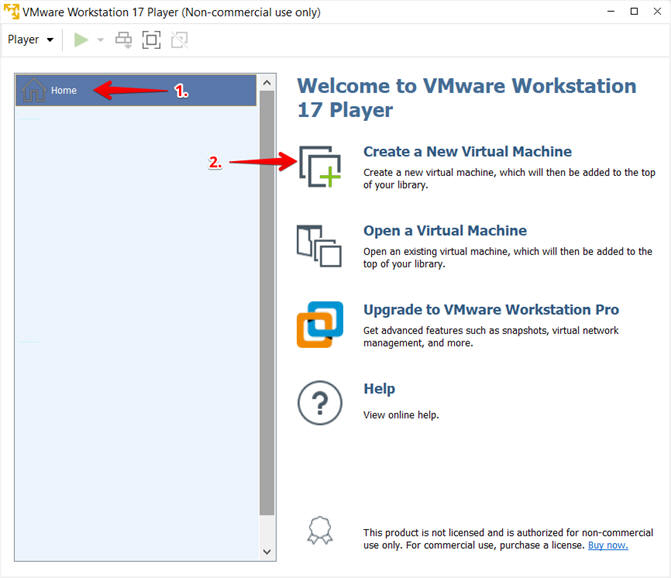
- Installation Media
- Instructions:
- Select the radio button "Installer disc
image file (iso):"
- Click the Browse Button.
- Navigate to where your Kali iso is
located and select it.
- Click Next

- Select a Guest Operating System
- Instructions:
- Guest operating system: Linux
- Version: Ubuntu 64-bit
- Select Next
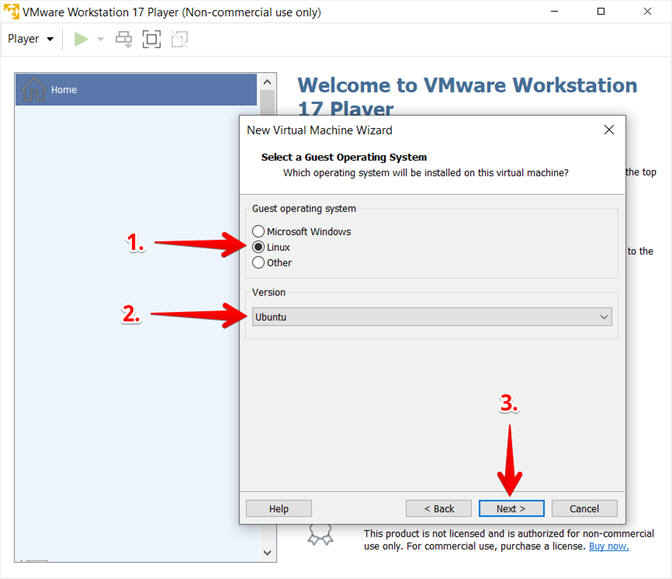
- Name the Virtual Machine
- Instructions:
- Virtual machine name:
kali2
- Location:
Accept or Provide storage location
- E.g., C:\Users\student\Documents\Virtual Machines\kali2
- Click the Next Button
- Note(FYI):
- Step #2, Please save the Kali VM
where ever you desire.
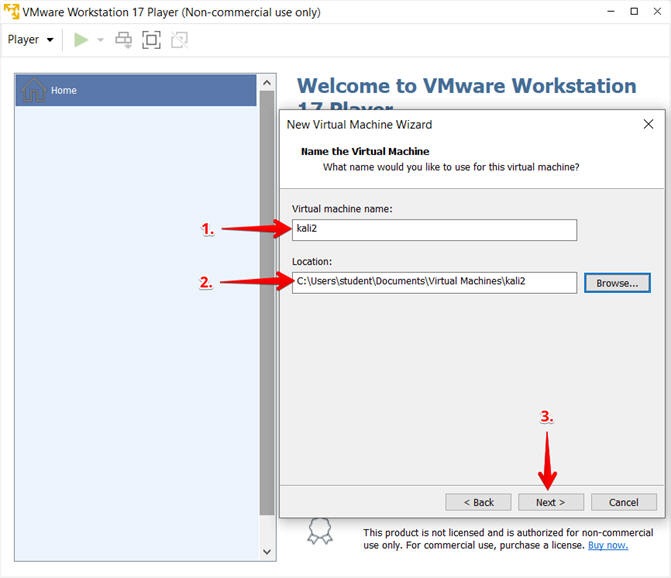
- New Virtual Machine Wizard
- Instructions:
- Maximum disk size (GB): For our purposes use
40GB.
- Radio Button: Store virtual disk
as an single file
- Select Next
- Note(FYI):
- Step #1, I choose 40GB instead
of 20GB, because future forensics lessons might require some extra
space.
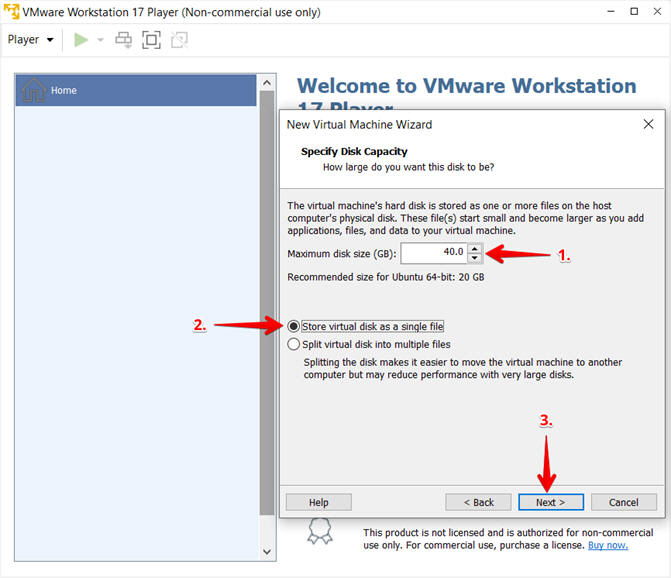
- Customize Hardware
- Instructions:
- Click on the "Customize Hardware..."
button
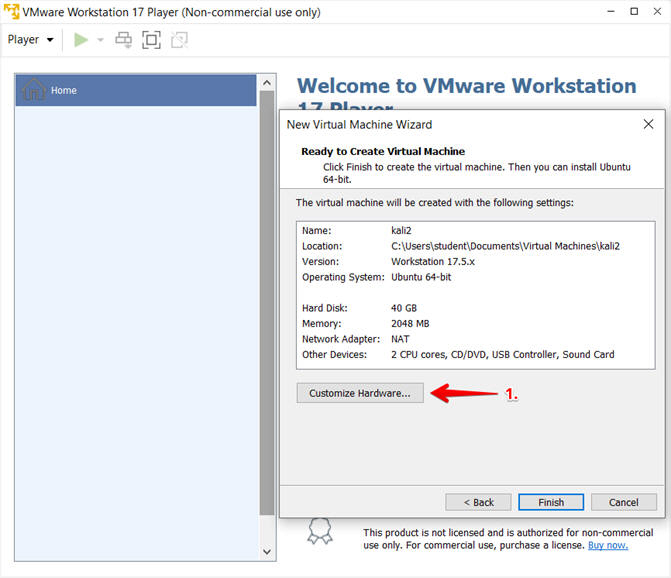
- Configure Memory Settings
- Instructions:
- Click on Memory (which is highlighted
in blue)
- Make sure
2048 MB is selected.
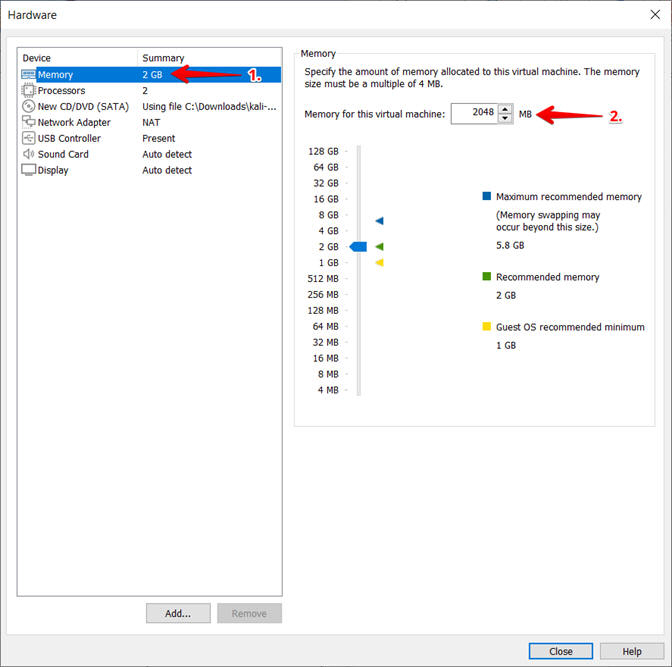
- Configure Network Adapter Settings
- Instructions:
- Click on Network Adapter (which is highlighted
in blue)
- Select Bridged: Connected directly to
the physical network
- Click on the Close Button
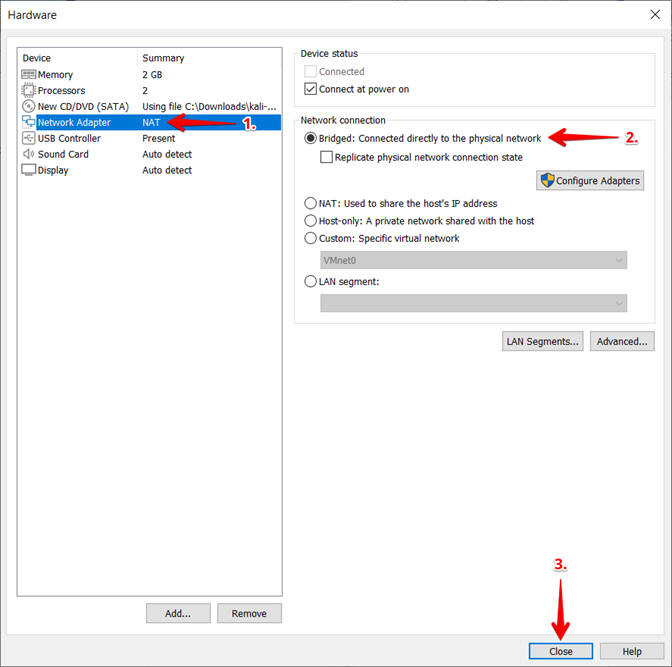
- Click on the Finish button.
- Instructions:
- Click the Finish button
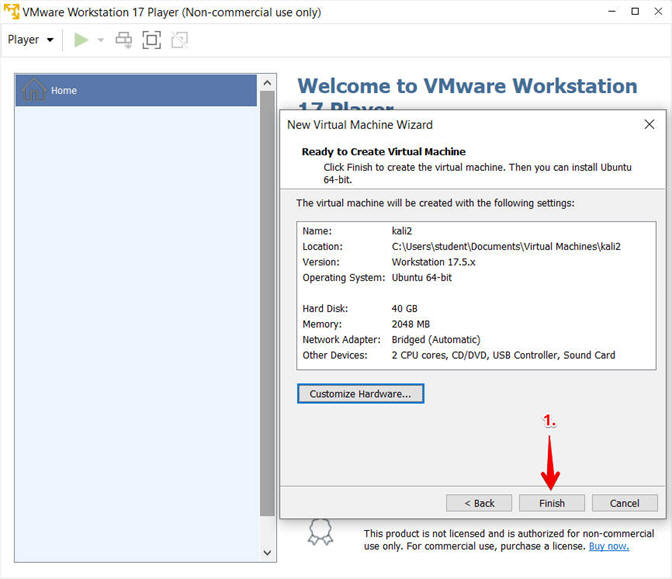
|
Section 3. Start
Installation |
- Start the Kali VM
- Instructions:
- Click on the kali2 VM
- Click on Play virtual machine
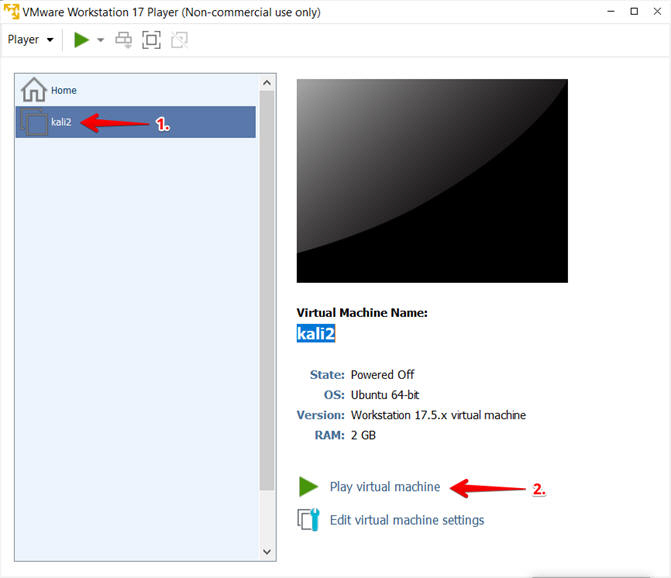
- Kali Linux Boot Menu
- Instructions:
- Arrow Down to
Graphical Installer
- Press <Enter>

- Select a Language
- Instructions:
- Click on English
- Click the Continue Button
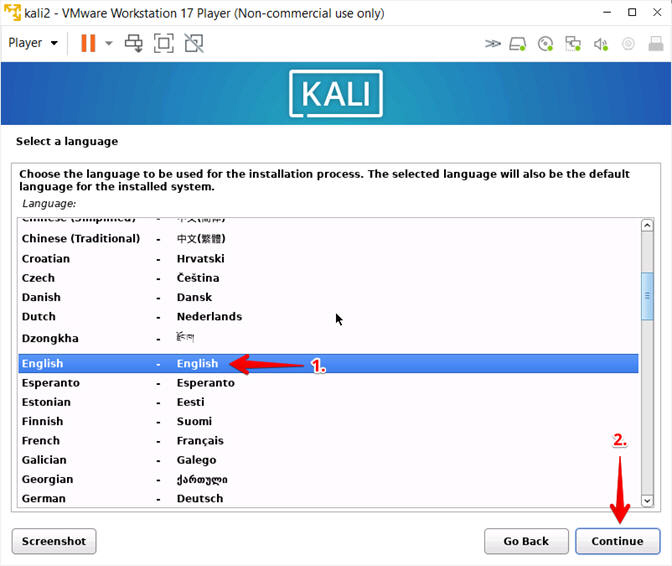
- Select your location
- Instructions:
- Click on United States
- Click the Continue Button
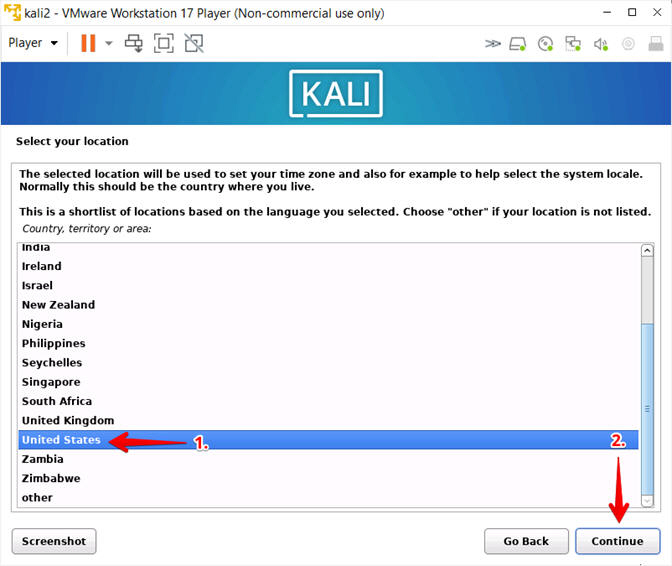
- Select the keyboard
- Instructions:
- Click on American English
- Click the Continue Button
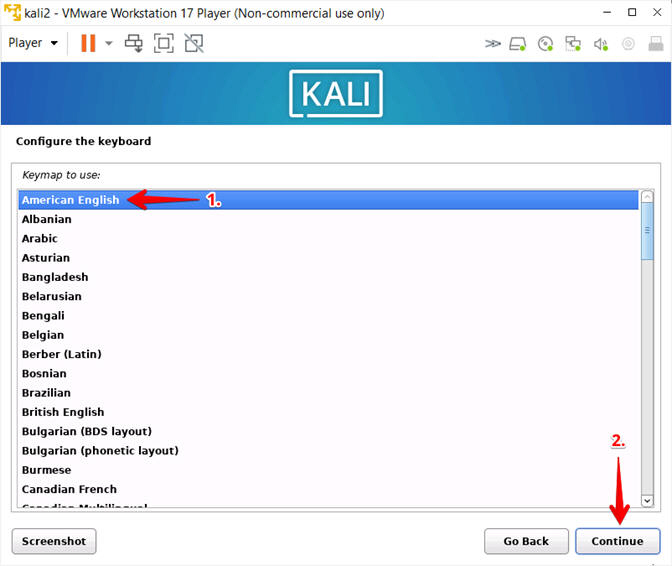
- Detecting Hardware Settings
- Note(FYI):
- Wait until finished before moving to
the next step
- Click the Continue Button
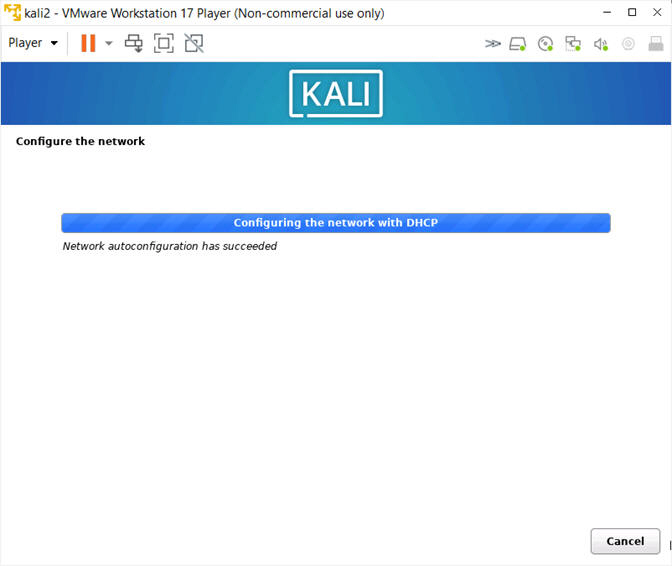
- Provide Hostname
- Instructions:
- Hostname:
kali2
- Click the Continue Button

- Provide Domain Name
- Instructions:
- Domain name: Leave this blank, unless
you can provide a domain name.
- Click the Continue Button
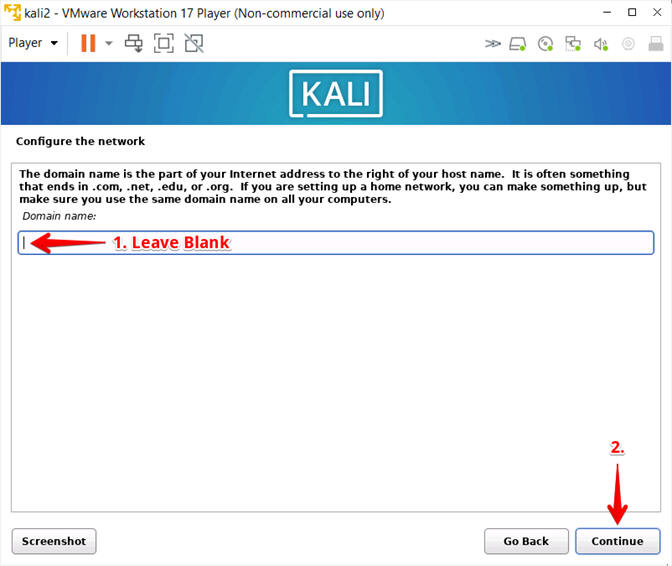
- Set up users and passwords (Part 1)
- Instructions:
- Full name for the new user:
Your Full Name
- Click the Continue Button
- Notes(FYI):
- Replace "Full
Name" with your name.
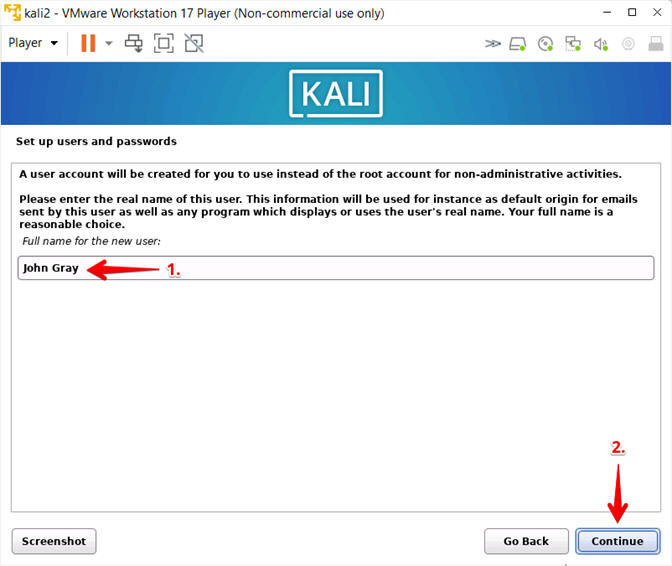
- Set up users and passwords (Part 2)
- Instructions:
- Username for your account:
student
- Click the Continue Button
- Set up users and passwords (Part 3)
- Instructions:
- User password: Provide a password
- Re-Enter User password to verify:
Provide the same password
- Click the Continue Button
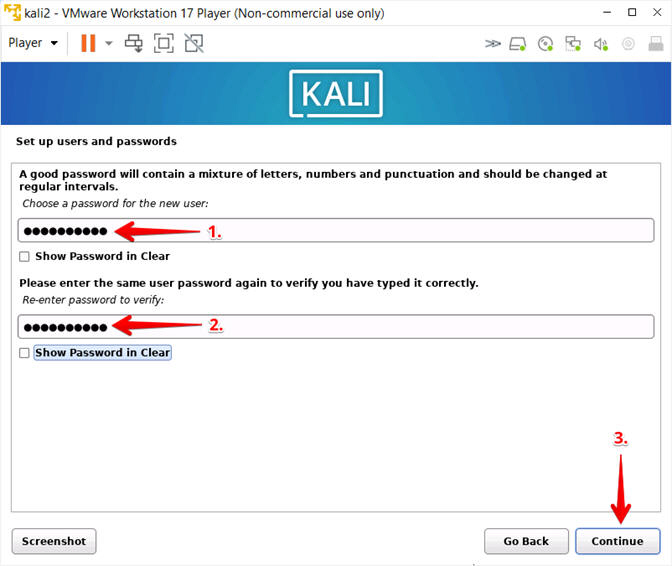
- Configure the clock
- Instructions:
- Select your time zone (E.g., Central)
- Click the Continue Button
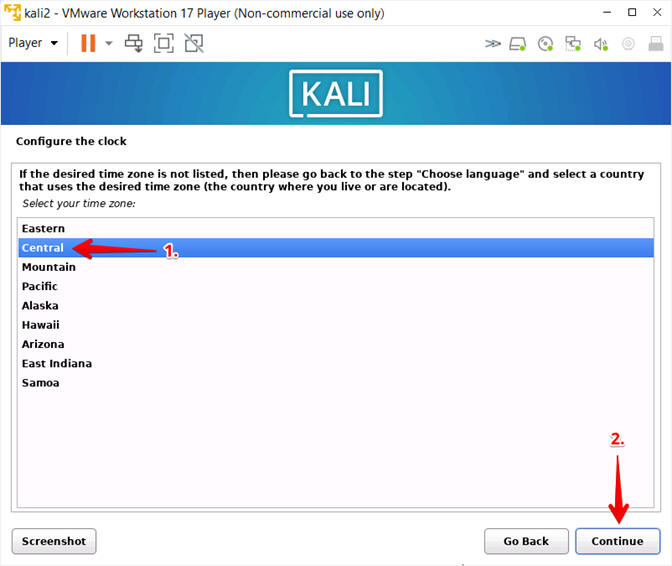
- Select Partition Option
- Instructions:
- Click on Guided - use entire disk
- Click the Continue Button

- Select disk to partition
- Instructions:
- Click on the disk (See picture)
- Click the Continue Button
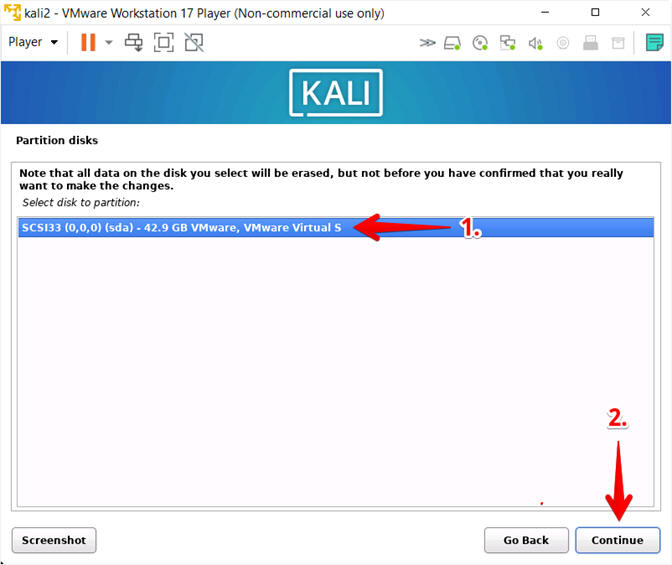
- Partitioning Scheme
- Instructions:
- Click on "All file in one partition
(recommended for new users)"
- Click the Continue Button
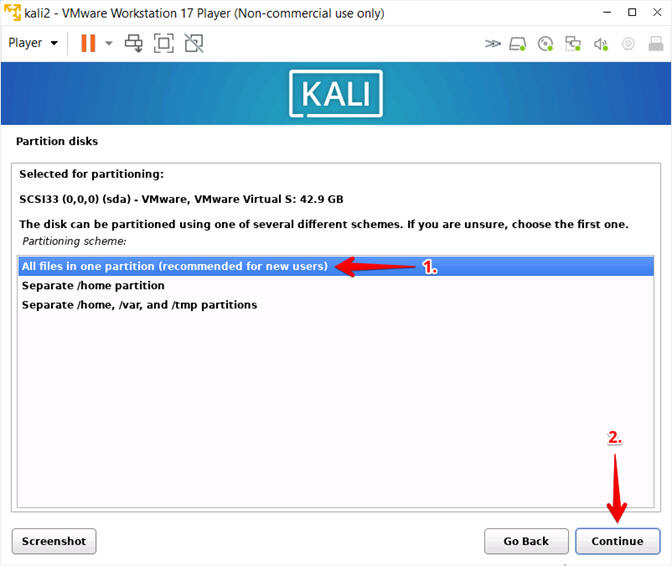
- Partition Overview
- Instructions:
- Click on "Finish partitioning and
write changes to disk"
- Click the Continue Button
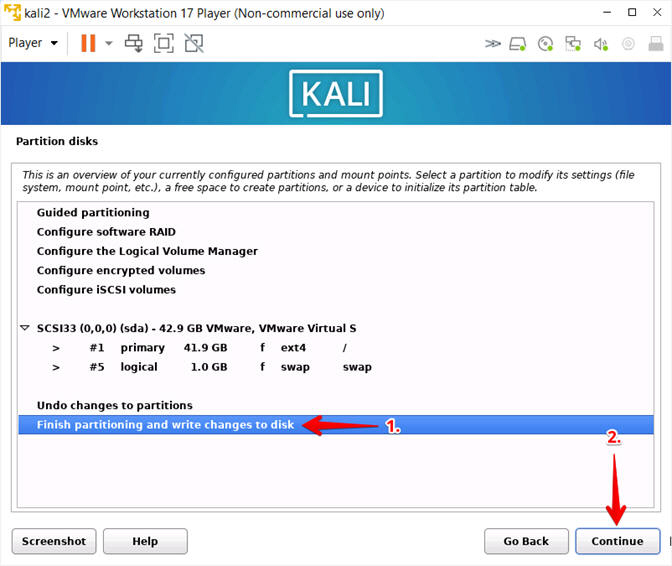
- Write the changes to disks?
- Instructions:
- Click the Yes radio button
- Click the Continue Button

- Install the system
- Note(FYI):
- This will take about 15 to 30 minutes.
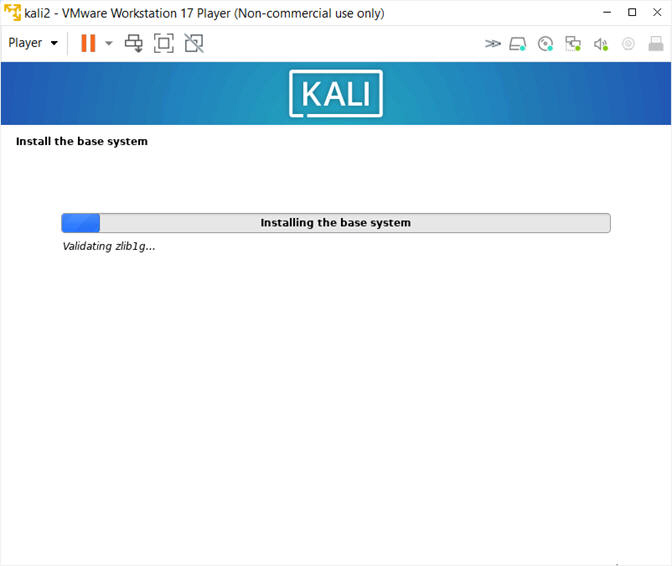
- Software Selection
- Instructions:
- Accept the Default Selections
- Click the Continue Button

- Select and install software
- Note(FYI):
- The installation will take between 30
to 45 minutes
- Install the GRUB boot loader on a hard disk
(Part 1)
- Instructions:
- Click the Yes radio button
- Click the Continue Button
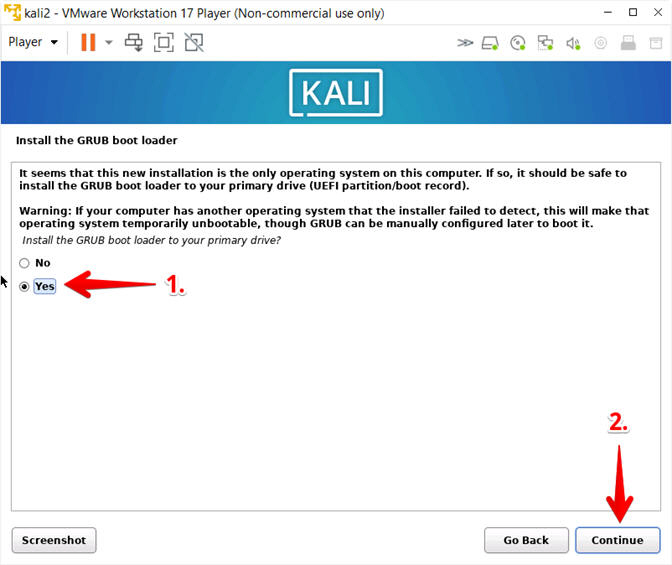
- Install the GRUB boot loader on a hard disk
(Part 2)
- Instructions:
- Select /dev/sda
- Click the Continue Button
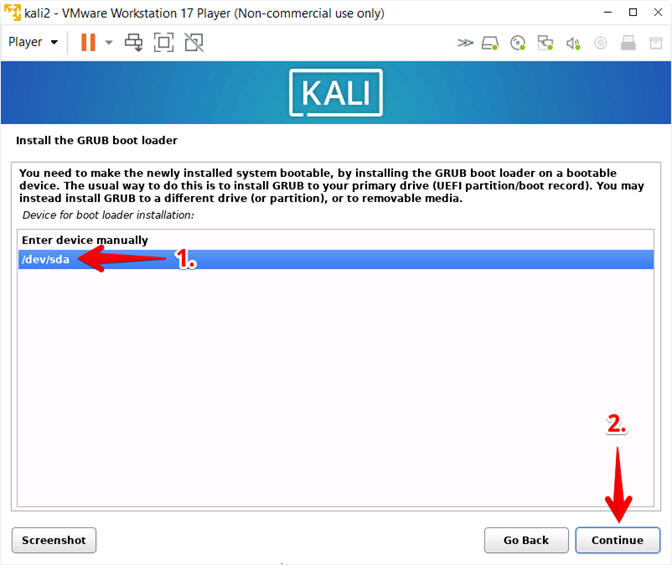
- Finish the installation
- Instructions:
- Click the Continue Button
- Supply Username and Password
- Instructions:
- Username: Provide the username you
created in (Section 3, Step 10).
- Password: Provide the password you
created in (Section 3, Step 11).
- Click the Log In Button
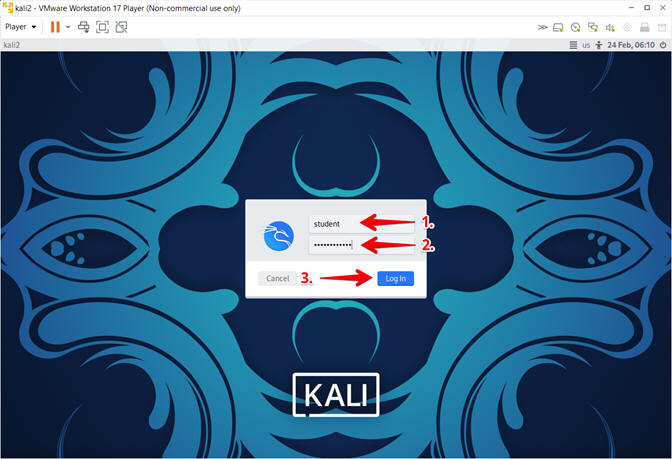
- Virtual Machine Settings
- Instructions:
- Player --> Manage -->
Virtual Machine Settings...
- Note(FYI):
- We will un-mount or eject the CD/ISO
because we no longer need it.
- If you still have a CD/DVD Drive on
your host machine they tray might actually open.

- CD/DVD Settings
- Instructions:
- Highlight
CD/DVD (IDE)
- Select Connection: Use physical drive
radio button
- Click the OK button
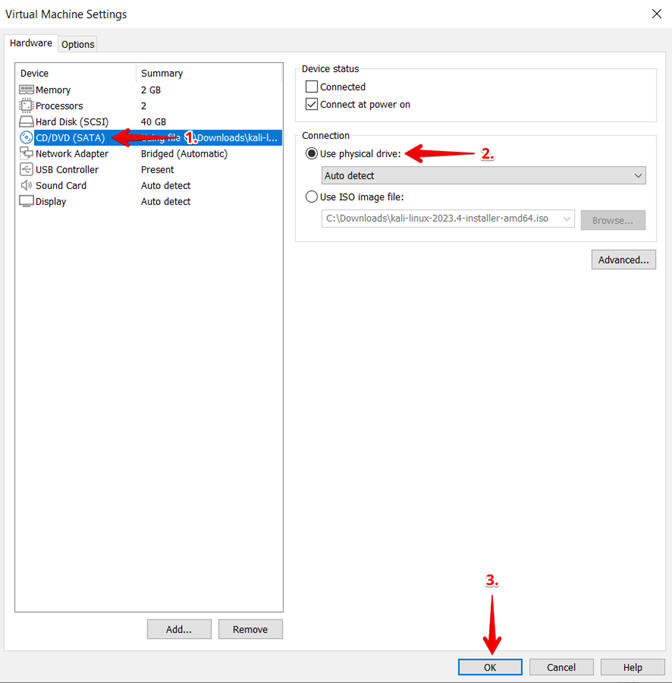
|
Section 6. Configure
Terminal Colors |
- Open a Terminal Emulator
- Instructions:
- Click the Kali Icon in the upper left
corner
- Search for the string
terminal
- Click on the Terminal Emulator Icon
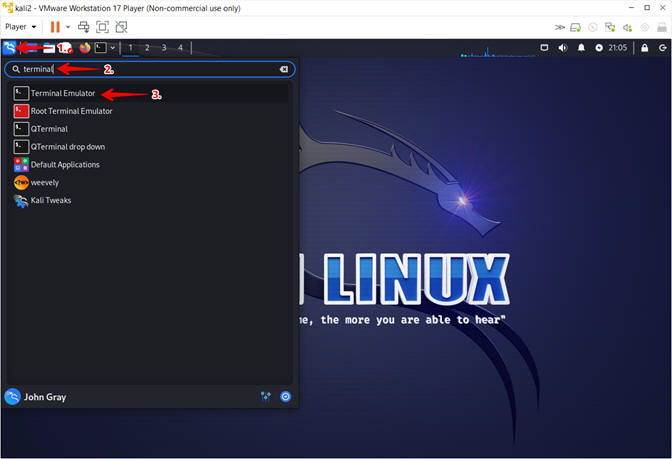
- Open Preferences
- Instructions:
- Click File
- Click Preferences
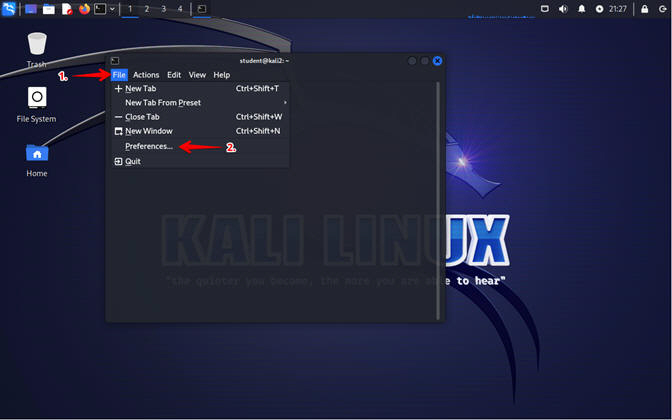
- Configure Preferences
- Instructions:
- Click Appearance
- Click Change

- Configure Font Size
- Instructions:
- Size: 12
- Click OK
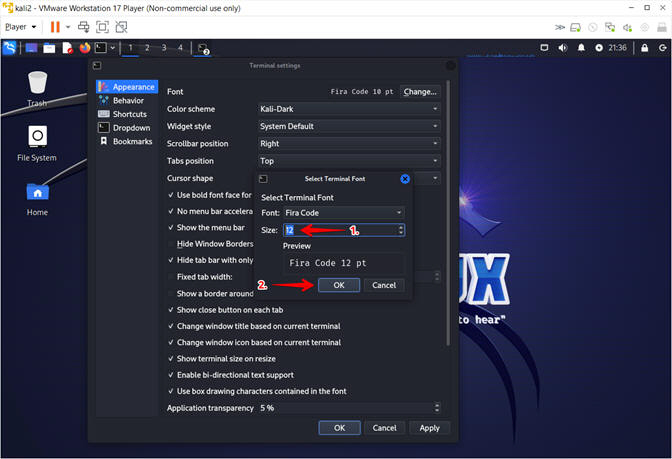
- Configure Font Size
- Instructions:
- Size: 12
- Click OK
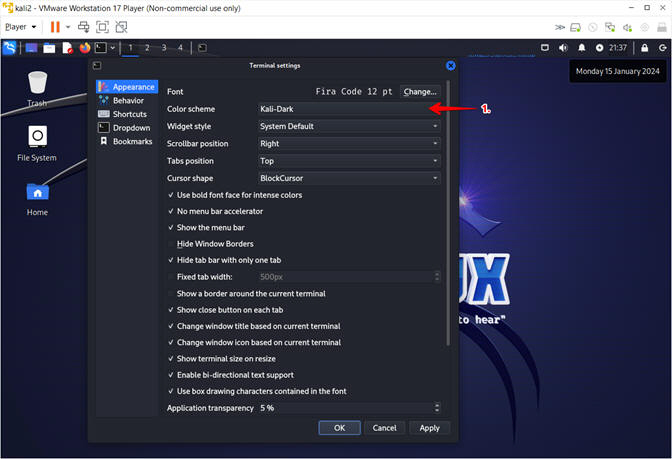
- Configure Color Scheme
- Instructions:
- Color scheme:
BlackOnWhite
- Click OK

- Configure Application Transparency
- Instructions:
- Application transparency: 0%
- Click OK
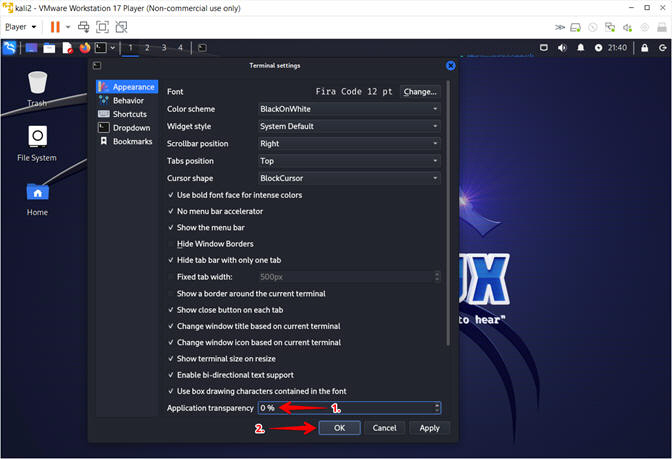
- Post-Configuration
- Note(FYI):
- Your terminal show now have a white
background
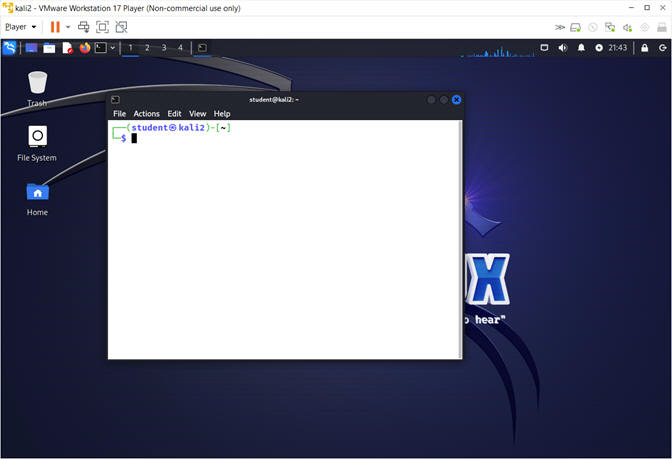
|
Section 7. Kali
Update and Upgrade (Optional) |
- Update Kali Repository
- Instructions:
-
sudo
apt-get
update
- Enter Password
-
Note(FYI)
- Arrow #1:
sudo
stands for "SuperUser DO" and is used to
access restricted files and operations.
- Arrow #1:
apt-get is the
command-line tool for handling packages
- Arrow #1: The (update)
option is used to resynchronize the package index files from their
sources. The indexes of available packages
are fetched from the location(s) specified in /etc/apt/sources.list

- Perform Kali Full Upgrade
-
Note(FYI):
- Although it is a best practice to keep your
system updated, this is an optional.
- Instructions:
-
sudo
apt-get
-y
full-upgrade
-
Note(FYI):
-
This step
is optional and is not required.
- This will take between 45 to 120 minute until you see the
wireless screenshot in the following step.
- Arrow #1: (apt-get)is
the command-line tool for handling packages
- Arrow #1: The (-y)
option provides an automatic yes to interactive prompts.
- Arrow #1: The (full-upgrade)
option performs the function of upgrade but will remove currently
installed packages if this is needed to upgrade the system as a whole.
- Note, I did not perform a dist-upgrade
after experiencing and fixing various graphic issues.
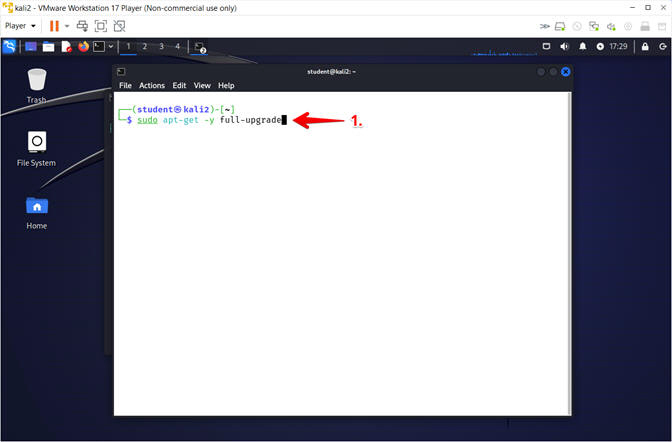
- Consistency Reboot
- Instructions:
- sudo reboot
- Note(FYI):
- A Reboot is necessary to activate all the
updates and VMware Tools.
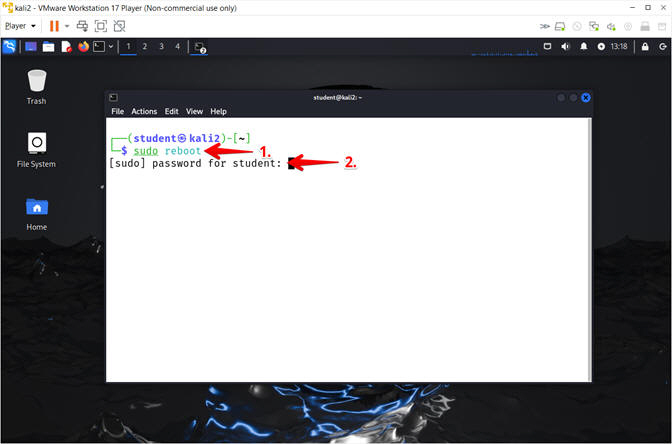
- Supply Credentials
- Instructions:
- Username: student
- Supply Password
- Click the Login Button

- Open Terminal
- Instructions:
- Click on the Terminal Icon
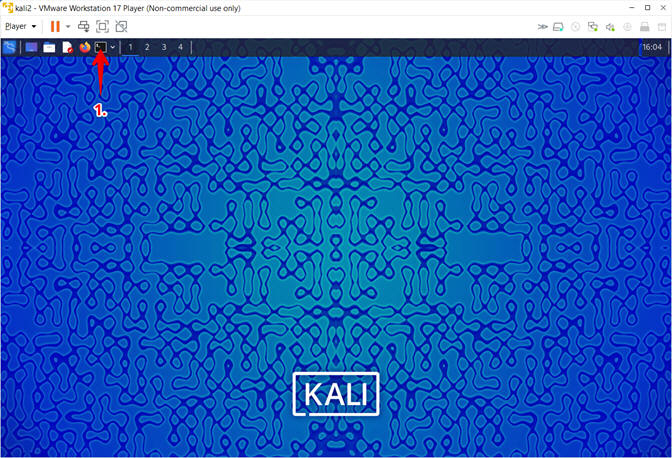
- Proof of Lab
- Note(FYI):
- Arrow #1, A new /boot/initrd will be
generated. The initrd (initial ramdisk) is a scheme for
loading a temporary root file system into memory in the boot process
of the Linux kernel.
- Instructions:
- ls -l /boot | grep initrd
- date
- echo "Your Name"
- Replace the string "Your Name" with
your actual name.
- e.g., echo "John Gray"
-
Proof of Lab Instructions
- Press both the <Ctrl> and <Alt> keys at
the same time.
- Press <PrtScn> Key
- Paste into a word document
- Upload to Moodle
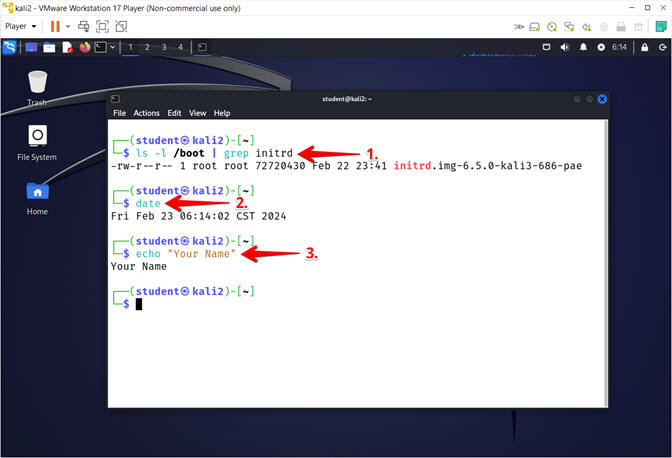
|
 
|






















































